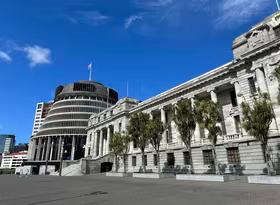Changing tack on interest rate expectations
Inflation has picked up rapidly and is set to spike higher in coming months, and the Reserve Bank has confirmed a strong tightening bias in its monetary policy settings. As a result, we have changed our outlook for monetary policy. We are now picking an increase in the official cash rate (OCR) next month, and we see potential for a rise of 50 basis points.
The Reserve Bank’s latest Monetary Policy Review (MPR) and Stats NZ inflation data provide a bumper crop of information to wade through and help determine the future path for interest rates.
When the MPR was published on 14 July, our immediate understanding was weaker than the interpretation of most forecasters, and we maintained our forecast for the OCR to lift in 2022. We have now changed that call given a range of factors.
The Reserve Bank’s MPR on 14 July took everyone by surprise, with the Large Scale Asset Purchases (LSAP) programme set to end by Friday 23 July. By ending LSAP, the Monetary Policy Committee “agreed to reduce the current stimulatory level of monetary settings”, and also stated that “recent data indicate the New Zealand economy remains robust”.
The Bank also removed a line from its previous Monetary Policy Statement (MPS) in May that “meeting [its monetary policy target] requirements will necessitate considerable time and patience”, and instead “noted that uncertainties remain as to the pace and magnitude of any pass-through of costs onto medium term inflation.”
However, our initial reading of the MPR, coupled with our understanding of monetary policy options (outlined in the next section), led us to the view that the Bank hadn’t upgraded its view on New Zealand’s economic activity or inflation that strongly. The MPR’s focus on near-term spikes in inflation being “one-off” or “temporary” seemed to downplay the near-term inflationary risks, particularly when coupled with the statement that “medium-term inflation and employment would likely remain below its Remit objectives in the absence of some ongoing monetary support.”
Since the start of 2021, weekly LSAP activity has declined from around $600m to $190m (see Chart 1). The Reserve Bank has been at pains to present this decline as an operational change and not a shift in monetary policy. Indeed, with a much lower level of bond issuance by the government than was expected a year ago, LSAP purchases needed to tail off to keep within the Bank’s operating guidelines of purchasing no more than 60% of available government bonds.
The Bank had unambiguously stated in May’s MPS “that the OCR is the preferred tool to respond to future economic developments in either direction” We subsequently discussed with the Bank how monetary policy support might be unwound, and the stance that the OCR would be the next tool to be adjusted was firmly reiterated.
With the Reserve Bank running out of scope to continue LSAP, and the firm view expressed by the Bank that the OCR was its favoured instrument, we saw the Bank’s decision to end LSAP as a distraction and a move of convenience, rather than a genuine monetary tightening.
However, following last week’s MPR, the Bank has confirmed to us that the ending of LSAP should be taken as a clear signal of monetary policy tightening, despite this move being a clear contradiction of its previously stated position. In our view, the Bank’s reiteration in the MPR that “the OCR is the preferred tool when responding to economic conditions in the future” should be disregarded, and that changes to the Funding for Lending Programme (FLP) could accompany any future OCR changes.
Inflation jumped from 1.5% to 3.3%pa in the June quarter – the fastest rate in a decade, and the fastest in 13 years if the 2011 increase in GST is excluded. Although the annual figure was swollen by unusually low prices in the June 2020 quarter, the 1.3% quarterly change highlights the strength of underlying price pressures. Faster inflation was driven by a broad set of price rises, including a substantial rise in building costs along with higher rent, fuel, used car, and clothing and footwear prices.
Import issues, supply chain disruptions, and higher freight costs all remain as key concerns for higher prices. These issues have been added to by rising wage pressures, as poaching of staff and difficulty finding workers increases, and higher energy prices, heaping more pressure on inflation expectations.
Global inflation expectations are also increasing. The last decade of low inflation has been helped by rampant expansion of Chinese manufacturing and other technological advancements that have kept goods costs low. But Chinese government restrictions on production to support its changing environmental strategy look likely to increase manufacturing prices heading forward.
Overall inflationary pressures are building to their greatest since the Global Financial Crisis. Infometrics forecasts show inflation sitting considerably higher by the end of 2023 compared to pre-pandemic forecasts. By the second half of 2023, we now expect average prices to be as much as 2.2% higher than we were predicting in our forecasts at the end of 2019.
With a clear signal from the Reserve Bank that tighter monetary policy is needed, and with stronger and probably more sustained inflationary pressures, we now expect the OCR to be increased in August. Given the strong inflation data, and signs of extreme tightness in various labour market indicators, we also highlight a rising chance that this increase could be 50 basis points, taking the OCR from 0.25% to 0.75%.
We also see potential for the Reserve Bank to change FLP settings to limit Tranche 2 support in the scheme. None of this tranche bas been drawn on yet, and so it remains relatively easy to tweak.
We note that the Bank is likely to be somewhat cautious about raising rates too quickly. In 2014, the OCR was lifted from 2.5% to 3.5%, only for the Bank to reverse the increases the following year when inflation failed to materialise. However, back in 2015, strong migration helped keep labour market pressures subdued and inflation in check. That “relief valve” is clearly not available for employers or the economy this time around.
Whatever the case, rising inflation and substantially better economic conditions make a clear case for less stimulus being needed. Even with the OCR rising from next month, monetary policy settings will remain supportive, just not to the same degree as they have been over the last 16 months.













